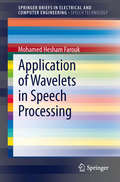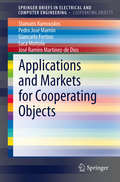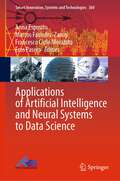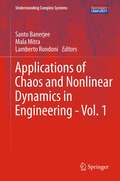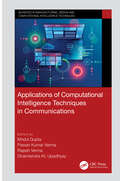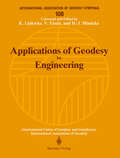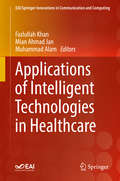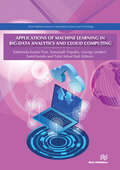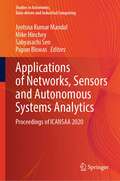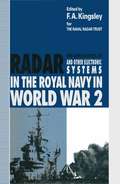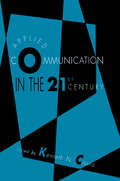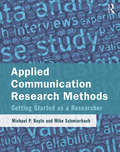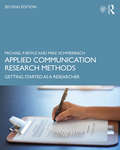- Table View
- List View
Application of Wavelets in Speech Processing (SpringerBriefs in Speech Technology)
by Mohamed Hesham FaroukThis book provides a survey on wide-spread of employing wavelets analysis in different applications of speech processing. The author examines development and research in different applications of speech processing. The book also summarizes the state of the art research on wavelet in speech processing.
Applications and Markets for Cooperating Objects (SpringerBriefs in Electrical and Computer Engineering)
by Stamatis Karnouskos Pedro José Marrón Giancarlo Fortino Luca Mottola José Ramiro Martínez-de DiosThis book provides an overview and an insight in cooperative objects and defines the classification of topics into the different areas. A significant number of researchers and industrial partners were contacted in order to prepare the roadmap. The book presents of the main results provided by the corresponding European project "CONET".
Applications in Electronics Pervading Industry, Environment and Society: APPLEPIES 2019 (Lecture Notes in Electrical Engineering #627)
by Sergio Saponara Alessandro De GloriaThis book provides a thorough overview of cutting-edge research on electronics applications relevant to industry, the environment, and society at large. It covers a broad spectrum of application domains, from automotive to space and from health to security, while devoting special attention to the use of embedded devices and sensors for imaging, communication and control. The book is based on the 2019 ApplePies Conference, held in Pisa, Italy in September 2019, which brought together researchers and stakeholders to consider the most significant current trends in the field of applied electronics and to debate visions for the future. Areas addressed by the conference included information communication technology; biotechnology and biomedical imaging; space; secure, clean and efficient energy; the environment; and smart, green and integrated transport. As electronics technology continues to develop apace, constantly meeting previously unthinkable targets, further attention needs to be directed toward the electronics applications and the development of systems that facilitate human activities. This book, written by industrial and academic professionals, represents a valuable contribution in this endeavor.
Applications in Ubiquitous Computing (EAI/Springer Innovations in Communication and Computing)
by Raman Kumar Sara PaivaThis book takes a deep dive into ubiquitous computing for applications in health, business, education, tourism, and transportation. The rich interdisciplinary contents of the book appeal to readers from diverse disciplines who aspire to create new and innovative research initiatives and applications in ubiquitous computing. Topics include condition monitoring and diagnostics; multi-objective optimization in design, multi-objective optimization of machining parameters, and more. The book benefits researchers, advanced students, as well as practitioners interested in applications of ubiquitous computing. Features practical, tested applications in ubiquitous computingIncludes applications such as health, business, education, electronics, tourism, and transportationApplicable to researchers, academics, students, and professionals
Applications of Artificial Intelligence and Neural Systems to Data Science (Smart Innovation, Systems and Technologies #360)
by Anna Esposito Marcos Faundez-Zanuy Francesco Carlo Morabito Eros PaseroThis book provides an overview on the current progresses in artificial intelligence and neural nets in data science. The book is reporting on intelligent algorithms and applications modeling, prediction, and recognition tasks and many other application areas supporting complex multimodal systems to enhance and improve human–machine or human–human interactions. This field is broadly addressed by the scientific communities and has a strong commercial impact since investigates on the theoretical frameworks supporting the implementation of sophisticated computational intelligence tools. Such tools will support multidisciplinary aspects of data mining and data processing characterizing appropriate system reactions to human-machine interactional exchanges in interactive scenarios. The emotional issue has recently gained increasing attention for such complex systems due to its relevance in helping in the most common human tasks (like cognitive processes, perception, learning, communication, and even "rational" decision-making) and therefore improving the quality of life of the end users.
Applications of Artificial Intelligence Techniques in Industry 4.0 (SpringerBriefs in Applied Sciences and Technology)
by Aydin AziziThis book is to presents and evaluates a way of modelling and optimizing nonlinear RFID Network Planning (RNP) problems using artificial intelligence techniques. It uses Artificial Neural Network models (ANN) to bind together the computational artificial intelligence algorithm with knowledge representation an efficient artificial intelligence paradigm to model and optimize RFID networks.This effort leads to proposing a novel artificial intelligence algorithm which has been named hybrid artificial intelligence optimization technique to perform optimization of RNP as a hard learning problem. This hybrid optimization technique consists of two different optimization phases. First phase is optimizing RNP by Redundant Antenna Elimination (RAE) algorithm and the second phase which completes RNP optimization process is Ring Probabilistic Logic Neural Networks (RPLNN). The hybrid paradigm is explored using a flexible manufacturing system (FMS) and the results are compared with well-known evolutionary optimization technique namely Genetic Algorithm (GA) to demonstrate the feasibility of the proposed architecture successfully.
Applications of Chaos and Nonlinear Dynamics in Engineering - Vol. 1 (Understanding Complex Systems)
by Santo Banerjee, Mala Mitra and Lamberto RondoniChaos and nonlinear dynamics initially developed as a new emergent field with its foundation in physics and applied mathematics. The highly generic, interdisciplinary quality of the insights gained in the last few decades has spawned myriad applications in almost all branches of science and technology—and even well beyond. Wherever quantitative modeling and analysis of complex, nonlinear phenomena is required, chaos theory and its methods can play a key role. This volume concentrates on reviewing the most relevant contemporary applications of chaotic nonlinear systems as they apply to the various cutting-edge branches of engineering. The book covers the theory as applied to robotics, electronic and communication engineering (for example chaos synchronization and cryptography) as well as to civil and mechanical engineering, where its use in damage monitoring and control is explored). Featuring contributions from active and leading research groups, this collection is ideal both as a reference and as a ‘recipe book’ full of tried and tested, successful engineering applications
Applications of Chaos and Nonlinear Dynamics in Science and Engineering - Vol. 2 (Understanding Complex Systems)
by Santo Banerjee, Lamberto Rondoni and Mala MitraChaos and nonlinear dynamics initially developed as a new emergent field with its foundation in physics and applied mathematics. The highly generic, interdisciplinary quality of the insights gained in the last few decades has spawned myriad applications in almost all branches of science and technology—and even well beyond. Wherever the quantitative modeling and analysis of complex, nonlinear phenomena are required, chaos theory and its methods can play a key role. This second volume concentrates on reviewing further relevant, contemporary applications of chaotic nonlinear systems as they apply to the various cutting-edge branches of engineering. This encompasses, but is not limited to, topics such as the spread of epidemics; electronic circuits; chaos control in mechanical devices; secure communication; and digital watermarking. Featuring contributions from active and leading research groups, this collection is ideal both as a reference work and as a ‘recipe book’ full of tried and tested, successful engineering applications.
Applications of Chaos and Nonlinear Dynamics in Science and Engineering - Vol. 4 (Understanding Complex Systems)
by Santo Banerjee Lamberto RondoniChaos and nonlinear dynamics initially developed as a new emergent field with its foundation in physics and applied mathematics. The highly generic, interdisciplinary quality of the insights gained in the last few decades has spawned myriad applications in almost all branches of science and technology—and even well beyond. Wherever quantitative modeling and analysis of complex, nonlinear phenomena is required, chaos theory and its methods can play a key role.his fourth volume concentrates on reviewing further relevant contemporary applications of chaotic and nonlinear dynamics as they apply to the various cuttingedge branches of science and engineering. This encompasses, but is not limited to, topics such as synchronization in complex networks and chaotic circuits, time series analysis, ecological and biological patterns, stochastic control theory and vibrations in mechanical systems.Featuring contributions from active and leading research groups, this collection is ideal both as a reference and as a ‘recipe book’ full of tried and tested, successful engineering applications.
Applications of Computational Intelligence Techniques in Communications (Advances in Manufacturing, Design and Computational Intelligence Techniques)
by Mridul Gupta, Pawan Kumar Verma, Rajesh Verma and Dharmendra Kr. UpadhyayThe book titled "Applications of Computational Intelligence Techniques in Communications" is a one-stop platform for the researchers, academicians, and people from industry to get a thorough understanding of the latest research in the field of communication engineering. Over the past decade, a manyfold increase in the use of computational intelligence techniques has been identified for obtaining the most optimal and timely solution to a problem. The various aspects covering the significant contribution of numerous computational intelligence techniques have been discussed in detail in this book. Today’s era of machine learning and Internet of Things (IoT) is demanding as high as possible data rate which has resulted into tremendous increased speed of communication. To match-up the pace, the computational intelligence is posing to be the most efficient and favourite tool. The book aims to cover the current technological advancements in the field of communication engineering and give a detailed prospect of computational intelligence to its readers. This book will be a great support to the people working in the field of IoT, machine learning, healthcare, optimization, filter design, 5G and beyond, signal processing etc. The chapters included here will expose its audience to various newly introduced and advanced computational intelligence techniques applicable in communication domain. The readers will be exposed multiple interdisciplinary areas of research in communication and will get the motivation to work in collaboration with other professionals from both the academia and industry.
Applications of Computational Intelligence Techniques in Communications (Advances in Manufacturing, Design and Computational Intelligence Techniques)
The book titled "Applications of Computational Intelligence Techniques in Communications" is a one-stop platform for the researchers, academicians, and people from industry to get a thorough understanding of the latest research in the field of communication engineering. Over the past decade, a manyfold increase in the use of computational intelligence techniques has been identified for obtaining the most optimal and timely solution to a problem. The various aspects covering the significant contribution of numerous computational intelligence techniques have been discussed in detail in this book. Today’s era of machine learning and Internet of Things (IoT) is demanding as high as possible data rate which has resulted into tremendous increased speed of communication. To match-up the pace, the computational intelligence is posing to be the most efficient and favourite tool. The book aims to cover the current technological advancements in the field of communication engineering and give a detailed prospect of computational intelligence to its readers. This book will be a great support to the people working in the field of IoT, machine learning, healthcare, optimization, filter design, 5G and beyond, signal processing etc. The chapters included here will expose its audience to various newly introduced and advanced computational intelligence techniques applicable in communication domain. The readers will be exposed multiple interdisciplinary areas of research in communication and will get the motivation to work in collaboration with other professionals from both the academia and industry.
Applications of Geodesy to Engineering: Symposium No. 108, Stuttgart, Germany, May 13–17, 1991 (International Association of Geodesy Symposia #108)
by Klaus Linkwitz Viktor Eisele Hans-Joachim MönickeAccuracy requirements of fractions of a millimeter for the positioning of beam-guiding magnets in synchrotons, monitor- ing of speedy sub-seatunnelling with lengths exceeding 25 km, the construction of extremely long bridges of suspension or "cast-and push"-type, but also geometrical industrial quality control and robot calibration in real time, and even the analysis of prestressed cable nets, are few examples of thechallenging new tasks demanding responses from the modern engineering-geodesist. In this volume, a general view of Engineering Geologyis presented, its state of the art and up-to-date information about recent scientific tasks, aims and methods. The contributions focus on Theoretical Aspects, Techniques of Measurements, Techniques of Data Processing and Computing, Reports About Selected Executed Projects, Special Tasks, e.g. Realtime Positioning and Navigation, Industrial Managements,Image Processing. But also the role of geo- desists in collaboration with civil and mechanical engineers, technical designers and architects is outlined. As a reference book, this volume will be useful for researchers, students and practitioners in Engineering Geodesy and neighbouring disciplines.
Applications of Intelligent Technologies in Healthcare (EAI/Springer Innovations in Communication and Computing)
by Fazlullah Khan Mian Ahmad Jan Muhammad AlamThis book covers topics related to medical practices from communications technology point of view. The book provides detailed inside information about the use of health informatics and emerging technologies for the well-being of patients. Each chapter in this book focuses on a specific development in the use of informatics in healthcare. In general, each chapter uses various emerging technologies such as Internet of Things (IoT), Big Data, Cloud computing, Wireless Body Area Networks (WBAN), for various health-related illness, such as tuberculosis, heart diseases, asthma and various epidemic outbreaks. The book is intended both for communications engineers with a healthcare focus and medical researchers.
Applications of Machine Learning in Big-Data Analytics and Cloud Computing (River Publishers Series In Information Science And Technology Ser.)
by Subhendu Kumar Pani Somanath Tripathy George Jandieri Sumit Kundu Talal Ashraf ButtCloud Computing and Big Data technologies have become the new descriptors of the digital age. The global amount of digital data has increased more than nine times in volume in just five years and by 2030 its volume may reach a staggering 65 trillion gigabytes. This explosion of data has led to opportunities and transformation in various areas such as healthcare, enterprises, industrial manufacturing and transportation. New Cloud Computing and Big Data tools endow researchers and analysts with novel techniques and opportunities to collect, manage and analyze the vast quantities of data. In Cloud and Big Data Analytics, the two areas of Swarm Intelligence and Deep Learning are a developing type of Machine Learning techniques that show enormous potential for solving complex business problems. Deep Learning enables computers to analyze large quantities of unstructured and binary data and to deduce relationships without requiring specific models or programming instructions.This book introduces the state-of-the-art trends and advances in the use of Machine Learning in Cloud and Big Data Analytics. The book will serve as a reference for Data Scientists, systems architects, developers, new researchers and graduate level students in Computer and Data science. The book will describe the concepts necessary to understand current Machine Learning issues, challenges and possible solutions as well as upcoming trends in Big Data Analytics.
Applications of Machine Learning in Big-Data Analytics and Cloud Computing
Cloud Computing and Big Data technologies have become the new descriptors of the digital age. The global amount of digital data has increased more than nine times in volume in just five years and by 2030 its volume may reach a staggering 65 trillion gigabytes. This explosion of data has led to opportunities and transformation in various areas such as healthcare, enterprises, industrial manufacturing and transportation. New Cloud Computing and Big Data tools endow researchers and analysts with novel techniques and opportunities to collect, manage and analyze the vast quantities of data. In Cloud and Big Data Analytics, the two areas of Swarm Intelligence and Deep Learning are a developing type of Machine Learning techniques that show enormous potential for solving complex business problems. Deep Learning enables computers to analyze large quantities of unstructured and binary data and to deduce relationships without requiring specific models or programming instructions.This book introduces the state-of-the-art trends and advances in the use of Machine Learning in Cloud and Big Data Analytics. The book will serve as a reference for Data Scientists, systems architects, developers, new researchers and graduate level students in Computer and Data science. The book will describe the concepts necessary to understand current Machine Learning issues, challenges and possible solutions as well as upcoming trends in Big Data Analytics.
Applications of Networks, Sensors and Autonomous Systems Analytics: Proceedings of ICANSAA 2020 (Studies in Autonomic, Data-driven and Industrial Computing)
by Mike Hinchey Papun Biswas Jyotsna Kumar Mandal Sabyasachi SenThis book presents high-quality research papers presented at International Conference on Applications of Networks, Sensors and Autonomous Systems Analytics (ICANSAA 2020), held during December, 11 – 12, 2020, at JIS College of Engineering, Kalyani, West Bengal, India. The major topics covered are cyber-physical systems and sensor networks, data analytics and autonomous systems and MEMS and NEMS with applications in biomedical devices. It includes novel and innovative work from experts, practitioners, scientists, and decision-makers from academia and industry.
The Applications of Radar and Other Electronic Systems in the Royal Navy in World War 2
by F. A. KingsleyThis book presents a collection of authoritative accounts of the evolution and application of Royal Naval shipborne radars during World War 2 in the fields of weapon control, weapon direction, action information and fighter direction. Accounts are also presented of the successful pioneering activities at the Admiralty Signal Establishment in the fields of counter-measures against various enemy electronic systems in active operations, and also of high-frequency direction-finding, ashore and afloat, which, in conjunction with radar, contributed substantially to winning the Battle of the Atlantic.
Applied Analysis, Computation and Mathematical Modelling in Engineering: Select Proceedings of AACMME 2021 (Lecture Notes in Electrical Engineering #897)
by Santanu Saha Ray H. Jafari T. Raja Sekhar Suchandan KayalThis book is a compendium of the proceedings of the International Conference on Applied Analysis, Computation, and Mathematical Modelling in Engineering (AACMME-2021). The book covers a variety of applications such as mechanical, acoustical, physical, electrical, bio-mathematical, and computational fluid dynamics. Since mathematical modeling necessitates a wide range of skills and methods, the book concentrates on techniques that will be of specific interest to engineers, scientists, and those who work with discrete and continuous systems models. This book guides students, researchers, and professionals through the new approaches, the powerful tools for quickly mastering the most popular mathematical and computational models used in engineering and science. These new approaches enable readers to not only systematically create effective models, but also extend these models to any macroscopic physical structure.
Applied Aspects of Optical Communication and LIDAR
by Nathan Blaunstein Shlomi Arnon Natan Kopeika Arkadi ZilbermanExploring the practical aspects of atmospheric optical communication and light detection and ranging (LIDAR), Applied Aspects of Optical Communication and LIDAR details the role of atmospheric structures in propagation phenomena that influence the transmission of optical signals through perturbed atmospheric communication channels. It examines nume
Applied Communication in the 21st Century (Routledge Communication Series)
by Kenneth N. CissnaThe future of the field of communication lies in the ability to produce a socially relevant scholarship, without which the field is unlikely to attract the best students, command significant societal resources, or make its greatest contributions to the world's store of knowledge. This volume presents a report of the first discipline-wide, nationally sponsored communication research conference in 20 years--the Tampa Conference on Applied Communication. As the next millennium approaches, the communication field will be challenged to take its place among the disciplines whose research makes a substantial contribution to the well-being of society. How the communication field should respond to that challenge was the focus of the conference and this volume. Crossing all disciplinary boundaries, Applied Communication in the 21st Century addresses issues of concern to all scholars in the communication field, regardless of their various subareas, and includes the recommendation of the conferees concerning issues and responsibilities of the field, research priorities, and graduate education.
Applied Communication in the 21st Century (Routledge Communication Series)
by Kenneth N. CissnaThe future of the field of communication lies in the ability to produce a socially relevant scholarship, without which the field is unlikely to attract the best students, command significant societal resources, or make its greatest contributions to the world's store of knowledge. This volume presents a report of the first discipline-wide, nationally sponsored communication research conference in 20 years--the Tampa Conference on Applied Communication. As the next millennium approaches, the communication field will be challenged to take its place among the disciplines whose research makes a substantial contribution to the well-being of society. How the communication field should respond to that challenge was the focus of the conference and this volume. Crossing all disciplinary boundaries, Applied Communication in the 21st Century addresses issues of concern to all scholars in the communication field, regardless of their various subareas, and includes the recommendation of the conferees concerning issues and responsibilities of the field, research priorities, and graduate education.
Applied Communication Research Methods: Getting Started as a Researcher
by Michael Boyle Mike SchmierbachApplied Communication Research Methods: Getting Started as a Researcher demonstrates how to apply concepts to research problems, issues, projects, and questions that communication practitioners face every day. Recognizing that students engage more directly with research methods when they experience research through hands-on practice, authors Michael Boyle and Mike Schmierbach developed this text to demonstrate the relevance of research in professional roles and communication careers. Along with its distinctive approach to research methods instruction, this text also serves as an enhanced glossary and a superior reference. Students can easily navigate key concepts and terminology, which are linked to practical exercises within the context of the instruction. In-unit activities and features provide numerous opportunities to delve further into topics covered in class, including: Research in Depth – examples of a concept being used in scholarly research Reflect and React – thought-provoking problems and issues that promote reflection and discussion Voices from Industry – Q&As with professionals working in communication industries End-of-unit activities – exercises that reinforce concepts and content Online resources, including sample syllabi, test banks, and more, are available on the companion website: www.routledge.com/cw/boyle.Applied Communication Research Methods is a concise, engaging work that today’s students and industry practitioners will embrace and keep on-hand throughout their careers.
Applied Communication Research Methods: Getting Started as a Researcher
by Michael Boyle Mike SchmierbachApplied Communication Research Methods: Getting Started as a Researcher demonstrates how to apply concepts to research problems, issues, projects, and questions that communication practitioners face every day. Recognizing that students engage more directly with research methods when they experience research through hands-on practice, authors Michael Boyle and Mike Schmierbach developed this text to demonstrate the relevance of research in professional roles and communication careers. Along with its distinctive approach to research methods instruction, this text also serves as an enhanced glossary and a superior reference. Students can easily navigate key concepts and terminology, which are linked to practical exercises within the context of the instruction. In-unit activities and features provide numerous opportunities to delve further into topics covered in class, including: Research in Depth – examples of a concept being used in scholarly research Reflect and React – thought-provoking problems and issues that promote reflection and discussion Voices from Industry – Q&As with professionals working in communication industries End-of-unit activities – exercises that reinforce concepts and content Online resources, including sample syllabi, test banks, and more, are available on the companion website: www.routledge.com/cw/boyle.Applied Communication Research Methods is a concise, engaging work that today’s students and industry practitioners will embrace and keep on-hand throughout their careers.
Applied Communication Research Methods: Getting Started as a Researcher
by Michael Boyle Mike SchmierbachA hands-on guide for applying research methods to common problems, issues, projects, and questions that communication practitioners deal with on a regular basis, this text demonstrates the relevance of research in professional roles and communication careers. The second edition features updated material that covers major communication research methods including surveys, experiments, focus groups, observation research, while also providing key background information on ethics, validity, reliability, concept explication, statistical analysis, and other current topics. It continues to foster student engagement with research through its numerous features and practical activities, including: Research in Depth – examples of methods as applied in scholarly research Reflect and React – problems and issues that promote reflection and discussion Voices from Industry – Q&As with professionals working in communication industries End-of-unit activities – exercises that reinforce concepts and content The text is ideally suited to both undergraduate and graduate courses in mass communication research methods. Online resources, including sample syllabi, PowerPoint slides, and test banks are available on the companion website: www.routledge.com/cw/boyle.
Applied Communication Research Methods: Getting Started as a Researcher
by Michael Boyle Mike SchmierbachA hands-on guide for applying research methods to common problems, issues, projects, and questions that communication practitioners deal with on a regular basis, this text demonstrates the relevance of research in professional roles and communication careers. The second edition features updated material that covers major communication research methods including surveys, experiments, focus groups, observation research, while also providing key background information on ethics, validity, reliability, concept explication, statistical analysis, and other current topics. It continues to foster student engagement with research through its numerous features and practical activities, including: Research in Depth – examples of methods as applied in scholarly research Reflect and React – problems and issues that promote reflection and discussion Voices from Industry – Q&As with professionals working in communication industries End-of-unit activities – exercises that reinforce concepts and content The text is ideally suited to both undergraduate and graduate courses in mass communication research methods. Online resources, including sample syllabi, PowerPoint slides, and test banks are available on the companion website: www.routledge.com/cw/boyle.
